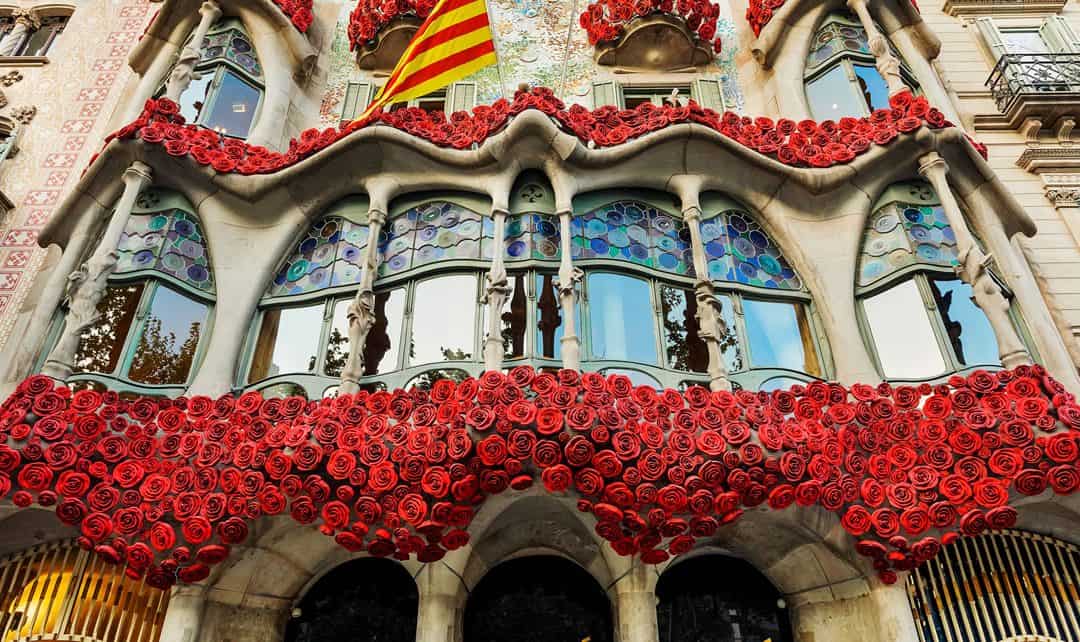Almost every day in Barcelona, you can find a few people gazing up at the home on 43 Passeig de Gràcia. The facade is a mix of colourful stone, glass and ceramics that’s been compared to a Monet painting, while the columns resemble bones and the protruding cast iron balconies are shaped like masks. No wonder it draws a small crowd.
Casa Batlló (the Batlló House) was designed by Antoni Gaudí (of La Sagrada Familia fame) and is considered one of his masterpieces. UNESCO named it a World Heritage Site and said that Gaudí’s work “anticipated and influenced many of the forms and techniques that were relevant to the development of modern construction in the 20th century.”
The house is open to visitors and is a marvel to see any time of year but on April 23, which is Saint George’s day (known as Sant Jordi in Catalonia), it’s extra special. That’s when the facade of the five-storey house is decorated with hundreds of red roses, attracting more than the usual crowds of onlookers and admirers.
Why roses and why on Casa Batlló? According to legend, Saint George (the patron saint of Catalonia) slayed a dragon as it was about to attack a princess. From the dragon’s blood, a rose bush appeared and the princess was offered one of the flowers.
For that reason, every year on April 23, roses – the real ones and artistic versions – are widely sold on the streets of towns and cities throughout Catalonia. (Coincidentally the day also marks the anniversary of the death of two great writers – Shakespeare and Cervantes – which is why April 23 is celebrated as “the day of books and roses” and gifts of both are exchanged).
Though Gaudí didn’t divulge the meaning of the symbolism contained in Casa Batlló, some people believe the legend of Saint George is expressed in the home’s design. Consider its arch-shaped roof that is often compared to a dragon’s back, and the multicoloured ceramic tiles with a metallic sheen that could pass for the animal’s scales.
The four-armed cross could represent the handle of a sword, while the bone-shaped columns might commemorate its victims. In fact, Casa Batlló has sometimes been called the “house of the dragon” or the “house of bones.”
Of course, the home didn’t look anything like this when it was originally constructed back in 1877. That changed in 1903 when textile industrialist Josep Batlló y Casanovas bought the building and gave Gaudí full creative rein, including the option to demolish the structure and start afresh.
Gaudí opted to work with the existing building and instead changed the facade, added floors, and reworked the internal partitioning. The central well, with its eye-catching tiles in varying shades of blue, was expanded, which added light to the entire building. The well also functions as the elevator shaft for a beautiful wooden lift, which is still in use today.
Other interior features include plenty of curving lines, irregular oval windows, sculpted stonework, doorknobs and banisters with ergonomic shapes and mosaics made from broken ceramic tiles.
Frequent references to nature and animals abound from the wavy ceiling, which evokes the sea; the mushroom-shaped fireplace in the study; the skylights in the entrance hall that resemble tortoise shells; and the series of 60 catenary arches in the loft that represent the ribcage of an animal.
The roof and terrace is one of home’s focal points. Aside from the famous dragon back design and the four-armed cross oriented to the cardinal directions, there are four oddly shaped chimney stacks (designed to prevent back draughts).
By the 1990s, Casa Batlló was purchased by the Bernat family, who opened it to the public. Today, visitors can purchase an audio guide and learn more while wandering at their leisure.
Some say the structure was part of the modernism movement of the day. But in many ways, Casa Batlló is in a class all its own, which is why it remains one of the most visited sites in Barcelona, attracting one million people every year.
Diane Slawych is a contributing writer for REM.













